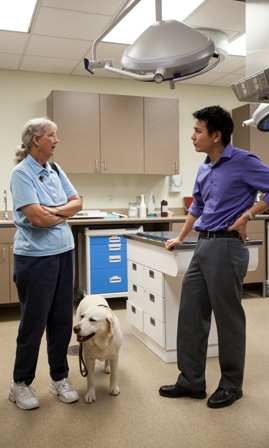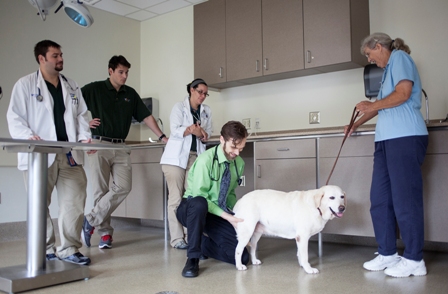First for UF: total knee
replacement surgery on dog
a success, veterinarians say

Kathleen Hornsby is shown with Mica and Dr. Stan Kim during a recheck appointment at the UF Small Animal Hospital on Oct. 10.
Nearly eight months after undergoing total knee replacement surgery at the University of Florida Small Animal Hospital, a 9-year-old yellow Labrador retriever named Mica is racing through fields four days a week, sniffing out ducks in blinds and swimming while she trains for her master hunting title. It was the first time the procedure has been performed at UF.
“She loves being back to work,” said Mica’s owner, Kathleen Hornsby, of Archer, Fla. Mica has also competed in conformation, holds a companion dog obedience title and was trained for tracking. “A younger dog not as thoroughly schooled as Mica might have had a harder time remembering everything, but a lot of the work these dogs do is instinctive. She just went right back to it, even the blind retrieves.”
UF’s veterinary surgeons performed the procedure Feb. 22 with the help of Matthew Allen, D.V.M., an Ohio State University veterinary surgeon with expertise in canine knee replacements. On Oct. 10, Mica received her latest clean bill of health during a check-up at UF.
“Total knee replacement is a new treatment option for dogs with severe osteoarthritis,” said Stan Kim, D.V.M., an assistant professor of small animal surgery at UF. “Due to the equipment and surgical expertise required, the procedure can only be performed at a small number of institutions in North America. We now have the ability at UF to restore excellent function to dog’s knees that are affected by a variety of disorders.”
The two-hour procedure involves completely replacing the surface of the stifle, or knee joint, with an implant that mimics the normal anatomy of the knee. Kim and Antonio Pozzi, D.V.M., an assistant professor of small animal surgery, performed the procedure with Allen.
“These implants took years to develop and are largely based on human total knee replacement systems,” Kim said.
In Mica’s case, her problems actually began when she was a 3-month-old puppy, racing around in the yard with her mother.

Dr. Justin Shmalberg examines Mica on Oct. 10 prior to checking the dog’s gait using force plate analysis. Veterinarians have monitored Mica’s recovery since the total knee surgery she received in February by periodically measuring how well she is bearing weight on her legs.
“Her mom raced over her, right on top of her left knee,” Hornsby said. “She screamed and hollered and limped for awhile and had surgery, but the veterinarians said back then that her knee would never be 100 percent normal, and she’d probably have arthritis in it.”
Mica’s owners treated her arthritis with medication, and the dog never limped when working, Hornsby said, adding, “When retrieving was on her mind, she didn’t even think about it.”
But in the past year-and-a-half, the limping grew worse. When Hornsby brought Mica to UF, surgeons said both her anterior and posterior cruciate ligaments were severely damaged, and the cartilage in her knee was completely worn away. This meant that the procedures UF veterinary surgeons typically use for an isolated anterior cruciate ligament injury would not work.
“They told us the only alternative was a total knee replacement,” Hornsby said.
UF veterinarians had never performed the surgery before, so they brought in Allen to assist and train them how to do the procedure.
Although humans have benefited from knee replacement technology for years, it has only been used in dogs with knee problems since 2007. Approximately 30 dogs per year have received the procedure since then, The New York Times reported in January 2011.
Total knee replacement is expensive, costing around $5,000, but Kim said UF is currently offering about a $1,000 discount — the cost of the implants, which are being provided free of charge — to owners of all dogs qualified to receive the procedure.
In the months following Mica’s surgery, she didn’t require retraining in her hunting abilities, just extensive physical therapy to build up her strength. Underwater treadmill therapy, stretching and bending twice a day and mile-long walks on a lead were part of the dog’s healing process.
UF veterinarians wouldn’t allow Mica to go off-lead for months after the procedure, saying the twisting and turning the dog might do if unsupervised could put unwanted stress on the knee prosthesis. But Hornsby said Mica ran her first post-surgery hunt test in August, and another one a month later with no leg problems.
Mica’s progress has exceeded veterinarians’ expectations, Kim said. Now, UF veterinarians will continue to monitor her annually to make sure she is doing well. During Mica’s check-ups, veterinarians use a weight-bearing machine known as a force plate to objectively measure how well she is using her leg.
“The most recent evaluation showed that her affected hind leg is gradually approaching the level of her normal hind leg,” Kim said.
The UF Small Animal Hospital is currently seeking dogs for a clinical study on total knee replacement. Dogs with severe osteoarthritis of the knee may be eligible.
Anyone seeking further information about the study may call Kim or Pozzi at 352-392-2235.










